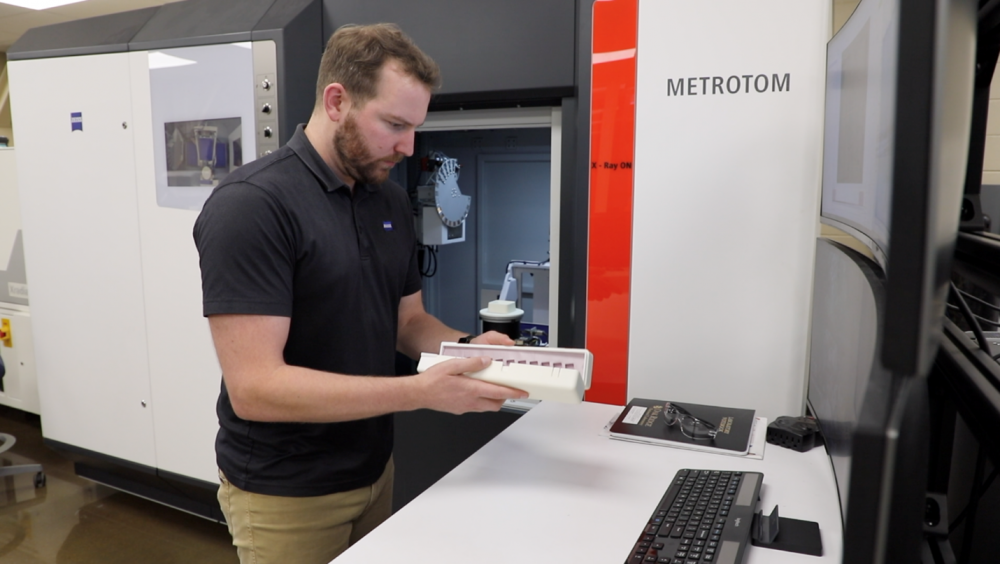A new deep-learning framework developed at the Department of Energy’s Oak Ridge National Laboratory is speeding up the process of inspecting additively manufactured metal parts using X-ray computed tomography, or CT, while increasing the accuracy of the results. The reduced costs for time, labor, maintenance and energy are expected to accelerate expansion of additive manufacturing, or 3D printing.
More from the News
“The scan speed reduces costs significantly,” said ORNL lead researcher Amir Ziabari. “And the quality is higher, so the post-processing analysis becomes much simpler.”
The framework is already being incorporated into software used by commercial partner ZEISS within its machines at DOE’s Manufacturing Demonstration Facility at ORNL, where companies hone 3D-printing methods.
ORNL researchers had previously developed technology that can analyze the quality of a part while it is being printed. Adding a high level of imaging accuracy after printing provides an additional level of trust in additive manufacturing while potentially increasing production.
“With this, we can inspect every single part coming out of 3D-printing machines,” said Pradeep Bhattad, ZEISS business development manager for additive manufacturing. “Currently CT is limited to prototyping. But this one tool can propel additive manufacturing toward industrialization.”
X-ray CT scanning is important for certifying the soundness of a 3D-printed part without damaging it. The process is similar to medical X-ray CT. In this case, an object set inside a cabinet is slowly rotated and scanned at each angle by powerful X-rays. Computer algorithms use the resulting stack of two-dimensional projections to construct a 3D image showing the density of the object’s internal structure. X-ray CT can be used to detect defects, analyze failures or certify that a product matches the intended composition and quality.
However, X-ray CT is not used at large scale in additive manufacturing because current methods of scanning and analysis are time-intensive and imprecise. Metals can totally absorb the lower-energy X-rays in the X-ray beam, creating image inaccuracies that can be further multiplied if the object has a complex shape. The resulting flaws in the image can obscure cracks or pores the scan is intended to reveal. A trained technician can correct for these problems during analysis, but the process is time- and labor-intensive.
Ziabari and his team developed a deep-learning framework that rapidly provides a clearer, more accurate reconstruction and an automated analysis. He will present the process his team developed during the Institute of Electrical and Electronics Engineers International Conference on Image Processing in October.
Training a supervised deep-learning network for CT usually requires many expensive measurements. Because metal parts pose additional challenges, getting the appropriate training data can be difficult. Ziabari’s approach provides a leap forward by generating realistic training data without requiring extensive experiments to gather it.
A generative adversarial network, or GAN, method is used to synthetically create a realistic-looking data set for training a neural network, leveraging physics-based simulations and computer-aided design. GAN is a class of machine learning that utilizes neural networks competing with each other as in a game. It has rarely been used for practical applications like this, Ziabari said.
Because this X-ray CT framework needs scans with fewer angles to achieve accuracy, it has reduced imaging time by a factor of six, Ziabari said — from about one hour to 10 minutes or less. Working that quickly with so few viewing angles would normally add significant “noise” to the 3D image. But the ORNL algorithm taught on the training data corrects this, even enhancing small flaw detection by a factor of four or more.
The framework developed by Ziabari’s team would allow manufacturers to rapidly fine-tune their builds, even while changing designs or materials. With this approach, sample analysis can be completed in a day instead of six to eight weeks, Bhattad said.
“If I can very rapidly inspect the whole part in a very cost-effective way, then we have 100% confidence,” he said. “We are partnering with ORNL to make CT an accessible and reliable industry inspection tool.”
ORNL researchers evaluated the performance of the new deep learning framework on hundreds of samples printed with different scan parameters, using complicated, dense materials. These results were good, and ongoing trials at MDF are working to verify that the technique is equally effective with any type of metal alloy, Bhattad said.
That’s important, because the approach developed by Ziabari’s team could make it far easier to certify parts made from new metal alloys. “People don’t use novel materials because they don’t know the best printing parameters,” Ziabari said. “Now, if you can characterize these materials so quickly and optimize the parameters, that would help move these novel materials into additive manufacturing.”
In fact, Ziabari said, the technology can be applied in many fields, including defense, auto manufacturing, aerospace and electronics printing, as well as nondestructive evaluation of electric vehicle batteries.
UT-Battelle manages Oak Ridge National Laboratory for DOE’s Office of Science, the single largest supporter of basic research in the physical sciences in the United States. DOE’s Office of Science is working to address some of the most pressing challenges of our time. For more information, visit energy.gov/science. — S. Heather Duncan
Subscribe to AM Chronicle Newsletter to stay connected: https://bit.ly/3fBZ1mP
Follow us on LinkedIn: https://bit.ly/3IjhrFq
Visit for more interesting content on additive manufacturing: https://amchronicle.com


